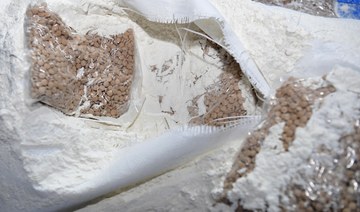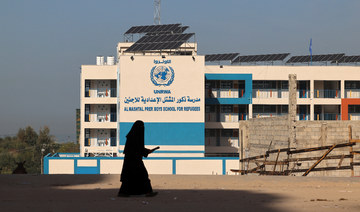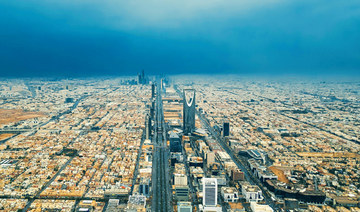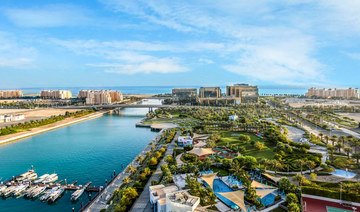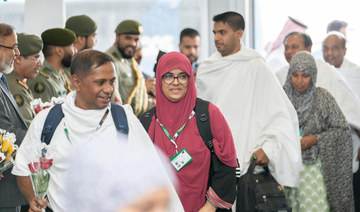RIYADH: In a bid to preserve and celebrate its rich cultural heritage, the Saudi Heritage Commission has cataloged more than 194 archaeological and heritage sites across the Baha region. These sites, including 72 traditional villages, have been classified and labeled with “barcode” plates, as outlined by the Heritage Commission’s data.
In Baha, picturesque scenes unfold as traditional villages and ancient structures dot the landscape, weaving through rugged terrain, vast expanses and diverse climate. These sites stand as testaments to a rich historical legacy, blending tradition, culture and craftsmanship.
Serving as vital components of national identity, the sites showcase a mosaic of cultural and social diversity while contributing significantly to the economy. They have also become magnets for travelers seeking to unearth the secrets of ancient civilizations crafted centuries ago by human hands.
The villages and historical landmarks stand as awe-inspiring testaments to ancient architectural prowess, with their homes, mosques, castles and forts echoing the rich heritage of bygone eras. Utilizing locally sourced materials such as stone, timber and sand, the inhabitants crafted roofs, pillars, doors and walls that seamlessly blend with the natural landscape.
Indigenous trees like juniper, spiny jujube (ziziphus spina christi), acacia and wild olive were skillfully shaped into intricate designs, their surfaces coated with a black tar. As time passed, the hues of these engravings evolved, adding depth and allure to the structures. Moreover, the construction also features granite and basalt rocks, adorned with exquisite marble accents, further enhancing the architectural marvels of the region’s historical sites.
Under the patronage of Prince Hussam bin Saud bin Abdulaziz, the governor of Baha, historic villages and sites in the region are receiving heightened attention and support. Prince Hussam has often emphasized the importance of these cultural riches in conserving the region’s history and contributing to national identity.
In his statements, Prince Hussam emphasizes the rich historical narrative buried in these sites, as well as their significance in communicating the tale of the region’s past and identity. He also highlights the abundance of archaeological and heritage villages scattered throughout the rugged landscapes of Baha, spanning from the highlands to the Tihama sector.
The governor advocates for the meticulous preservation of these villages, calling for collaborative efforts between government bodies, led by the Heritage Commission, and the local community, such as the development initiatives in several heritage villages that have been transformed into vibrant tourist destinations. Notable examples include the Thee Ain archaeological village, Al-Atawlah village, Al-Abadil village and Al-Mousa village.
These revitalized sites have become focal points for national tourism that extend a warm invitation to visitors and residents alike to delve into the rich tapestry of heritage nestled within the heart of Baha.
Mohammed Salem Al-Ghamdi, an elder in the region well versed in the architectural legacy of the area, said: “Since time immemorial, our ancestors have demonstrated a remarkable penchant for constructing stone and mud dwellings in close proximity, their shapes ranging from squares to rectangles or triangles, dictated by the landscape’s contours. These abodes typically feature two stories, with the ground level dedicated to livestock and provisions, while the upper floor serves as living quarters. The maze-like alleys and pathways foster a sense of closeness among residents, nurturing bonds of unity, affection and friendship.”
Al-Ghamdi said that the heritage villages stand as testaments to the resourcefulness of ancient civilizations, despite their limited means.
Moreover, the historic edifices in Baha echo with tales and anecdotes that chronicle pivotal moments in human civilization, serving as invaluable records of cultural evolution. They not only celebrate the region’s rich cultural heritage, but also exemplify the architectural brilliance of bygone eras.
In the picturesque village of Thee Ain nestled in Al-Makhwah, a tale unfolds through its bustling construction, as recounted by Yahya Al-Aref, a native of the village. With a history spanning more than 400 years, Thee Ain contains about 58 ancient stone houses, some intricately carved into the rugged mountainside. Earnestly dubbed the “Marble Village” for its distinctive architecture, these multi-story residences stand as silent witnesses to centuries gone by.
Surrounded by lush palm groves, banana plantations, fragrant basil and citrus trees, Thee Ain emanates an aura of authenticity, weaving together rich heritage, ancient origins and breathtaking aesthetics.
The heritage village of Al-Atawlah holds its own narrative. It is home to the Rubuh Quraish Market and the fortress of the Al-Othman sheikhs, along with the region’s first formal school.
Adjacent, the historic mosque, a centerpiece of the village, is undergoing a revival under Crown Prince Mohammed bin Salman’s initiative aimed at revitalizing historical mosques.
Venturing further, neighboring villages like Al-Khalaf and Al-Khalif unveil their own treasures, and are renowned for ancient Islamic inscriptions etched into basalt stones, including verses from the Qur’an and timeless supplications. Similarly, the cultural tapestry of Al-Mousa and Matair Al-Aish reverberates with echoes of history, each boasting a significant heritage waiting to be discovered.
Amid the heritage villages, a tapestry of historical richness unfolds in the region, showcasing not only quaint settlements, but also a treasure trove of historical sites. One such gem is the palace of Bin Raqoush nestled in Bani Saar, to the north of Baha. Erected in the year 1249 AH, the palace comprises five grand houses, some soaring to three floors, each intricately crafted in a distinctive architectural style.
A symphony of heritage unfolds within, featuring a tribal council chamber, an adjoining mosque, servant quarters, a wellspring of water and an intimate inner courtyard. Two additional houses encircle this palace, collectively forming a harmonious residential complex.
Further enhancing the historical mosaic is the Bakhrush Fortress, positioned in the northwest of the Qura governorate. This ancient citadel, with its soaring walls and twin towers, stands as a sentinel to the region’s storied past.
Meanwhile, the Al-Akhawayn Fortress surveys Al-Malad village with steadfast pride, perched atop a lofty hill and flanked by venerable heritage houses. Adding to this historical tapestry is Al-Ayed Heritage Guesthouse in Bani Kabir village, a haven of heritage museums that narrate the rich history and cultural legacy of the region.
These living artifacts, be they villages or historical sites, find themselves under the watchful eye of relevant authorities, with the commission spearheading efforts to breathe new life into these historical marvels.
Initiating a phased restoration of Thee Ain heritage village, the commission aims to secure its nomination for UNESCO’s prestigious World Heritage list. Simultaneously, significant attention has been directed toward revitalizing the Bin Raqoush Palace and turning it into a vibrant tourist destination.
Central to these endeavors is collaborative engagement with local communities, ensuring that restoration activities align with their needs and aspirations. This inclusive approach serves a dual purpose: Strengthening Saudi cultural identity while fostering a deeper sense of national cultural awareness and safeguarding heritage and social values.
Ali bin Mohammed Al-Suwat, mayor of the Baha region, underscores the region’s commitment to enhancing its heritage sites. This encompasses infrastructural improvements, aesthetic enhancements and the development of access routes. Municipal efforts are concentrated on the rehabilitation and paving of roads leading to these cultural treasures, accompanied by the installation of lighting infrastructure.
These initiatives not only accentuate the charm of heritage villages, but also cater to the region’s tourism and heritage development objectives.
Recent projects have seen pathways in heritage villages adorned with natural stone, covering extensive areas of more than 4,000 square meters. Furthermore, the installation and upkeep of more than 235 lighting poles along the pathways have illuminated the historical sites. Notably, with more than 900 square meters of electrical cables laid, 250 decorative external lighting fixtures have been strategically placed in prominent heritage sites such as the As-Sawad, Al-Hillah and Al-Abadil villages.
Revival of historic sites captures Baha’s timeless charm
https://arab.news/vg6y9
Revival of historic sites captures Baha’s timeless charm
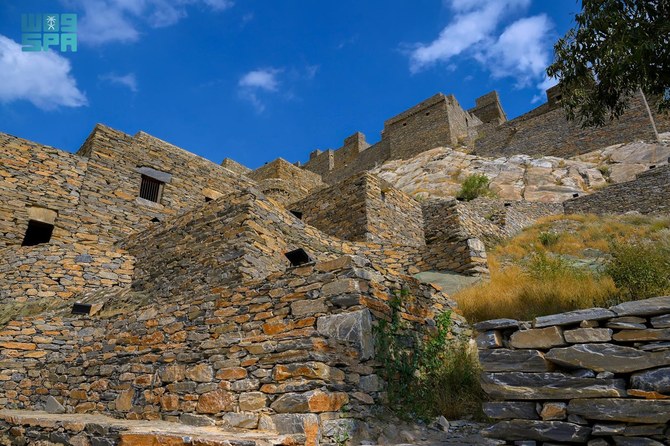
- Serving as vital components of national identity, the sites showcase a mosaic of cultural and social diversity while contributing significantly to the economy
- The villages and historical landmarks stand as awe-inspiring testaments to ancient architectural prowess
Saudi Arabia welcomes UN vote backing Palestinian bid for full membership

RIYADH: Saudi Arabia on Friday welcomed the adoption by the UN General Assembly of a resolution recognizing that the State of Palestine, currently an observer state, qualifies for full membership of the organization.
The 193-member assembly voted overwhelmingly in favor of the resolution, which also recommended that the Security Council reconsider the matter “favorably” and grant Palestine most of the rights and benefits that come with full membership.
The Kingdom’s Ministry of Foreign Affairs said the decision clearly expressed the international consensus on the inherent rights of the Palestinian people to self-determination and to establish an independent state within the framework of a two-state solution.
It added: “While the Kingdom appreciates the positive position of the countries that voted in favor of the resolution, it calls on the member states of the Security Council to assume their historical responsibility and not oppose the international consensus and stand up to the moral and legal right of the Palestinian people.”
In the vote on the resolution by the General Assembly, 143 members voted in favor, nine against, including US and Israel, and 25 abstained.
Royal Saudi Air Force concludes participation in ‘Desert Flag’ drill in UAE

RIYADH: The Royal Saudi Air Force on Friday ended its participation in the “Desert Flag” multinational air exercise at Al-Dhafra Air Base in the UAE, the Kingdom’s defense ministry said.
The RSAF took part alongside forces from a number of friendly countries.
Lt. Col. Adel Abu Malha, commander of the air force group participating in the exercise, said that the drill achieved its objectives — the exchange of military experience, boosting readiness and combat efficiency, and strengthening relations with the participating forces.
He said it also highlighted the professionalism of RSAF personnel.
The three-week drill included offensive, defensive and strategic counterair operations, as well as supporting ground forces within new and complex scenarios.
The Saudi air force participated with six F-15SA fighter aircraft, along with air, technical and support crews, while carrying out 80 day and night sorties and aerial refueling.
How building greener homes in Saudi Arabia could benefit the environment and well-being of homeowners

- Poor insulation of buildings and an overreliance on air conditioning is contributing to waste and environmental harm
- Green building materials, energy efficiency, and water conservation techniques could make homes more sustainable
RIYADH: The concept of sustainable living has gained significant traction in recent years as individuals and communities strive to reduce their environmental impact.
In Saudi Arabia, where rapid urbanization and economic growth have led to increased energy consumption and waste, the importance of adopting green living practices cannot be overstated.
The first thing that people should be aware of is electricity consumption and energy conservation. By investing in solar technology, homeowners can reduce their reliance on non-renewable energy sources and lower their electricity bills in the long run.
According to Thaer Qasem, senior energy engineer at SETS Saudi Arabia, a leading multidisciplinary engineering and consulting firm, Saudi Arabia’s residential sector consumed more than 47 percent of the total electricity produced in 2022.
Home cooling accounts for the largest share of that residential consumption and may reach up to 70 percent of that share, while lighting and other household appliances account for the rest.

“When designing or buying a new home, it is important to consider the insulation levels of walls and windows,” Qasem told Arab News. “The choice of building orientation can also increase natural light and help reduce heat absorption.
“To add value to your home, you may want to consider incorporating renewable energy systems like solar thermal units to heat domestic water and PV systems to generate electricity.
“Other techniques include purchasing equipment with a high-energy efficiency label and setting the AC temperature to at least 23 C.”
He added: “Smart home appliances and tools also provide excellent tools for conserving energy, allowing us to better monitor and control our usage and energy efficiency.”
Integrating smart home technology for monitoring and controlling energy usage allows residents to optimize their energy consumption and identify areas where efficiency can be improved.

Proper insulation, sealing, and the use of efficient HVAC (heating, ventilation and air conditioning) systems are also essential in preventing energy waste and maintaining a comfortable indoor environment, especially during the sweltering summer months.
Similarly, using recycled glass in countertops or tiles not only diverts waste from landfills but also reduces the energy required to produce new materials.
Also, selecting building materials with low volatile organic compounds can help maintain good indoor air quality, which is particularly important in a region like Saudi Arabia where individuals spend a significant amount of time indoors due to extreme temperatures.
By choosing green building materials, homeowners can not only lower their energy consumption and carbon footprint but also create healthier living spaces for themselves and their families.
Khalid Al-Harbi, an architect based in Riyadh, said a common misconception around sustainability is that it relies solely on the energy systems, equipment, and material choices used in the building. However, he believes a good design is an efficient design.
Opinion
This section contains relevant reference points, placed in (Opinion field)
“A well thought out architectural design that studies the needs of the users and considers the environmental factors will significantly reduce the cost and energy use of the building,” Al-Harbi told Arab News.
“Through studying the solar orientation of the sun in both summer and winter, we can decide on the most efficient placements of the windows and the shading systems needed such as exterior screens, outdoor shades, curtains, and so on, throughout the building.”
He continued: “We must also understand how the users will use the building and consider their need for natural lighting, as well as their privacy. We manage to achieve a good balance between maximum amount of natural light and privacy by incorporating inner courtyards, skylights, and windows with screens.”
Clay walls have emerged as a popular choice for eco-conscious homeowners due to their numerous benefits, including natural insulation properties, humidity regulation, and sustainability.
According to Adam Weismann, founding director of Clayworks and Claymoon, a business that has participated in numerous projects in Saudi Arabia, including the Red Sea International Airport and the King Faisal Cultural Center, clay is a sustainable, non-toxic alternative.

“From a sustainability perspective, clay has a very minimal carbon footprint because it is a pure substance with no chemicals,” Weismann told Arab News.
“Additionally, from a toxicity perspective, there is nothing that clay can truly release into the atmosphere. Thus, using it is a highly healthy and beneficial solution.”
Saudi Arabia is renowned for its clay houses, which fit seamlessly with the Kingdom’s natural aesthetic. Traditional architecture has long used sun-dried clay blocks, which remain cool during hot weather and release heat during the late hours when the temperature drops.
“Since not everyone lives in a large home, apartments can also use clay walls and ceilings,” said Weismann. “Paint would be completely omitted and clay would typically be used instead. It has all the advantages of that, including helping to absorb toxins.
“However, on a broader level, simply considering the materials you’re using and what you’re doing creates a small safe haven inside a larger apartment building where perhaps not as much thought was put into the materials.”
DID YOUKNOW?
• In 2022, Saudi Arabia’s residential sector consumed more than 47 percent of electrical output.
• Home cooling accounted for the largest share of that residential consumption.
• Air conditioning alone may soon account for 70 percent of consumption.
Weismann also proposed using clay under flooring with clay boards, which could be fitted with pipes carrying cool water, as an environmentally friendly alternative to air conditioning.
“Consequently, the building is being cooled by the cold water you are pushing through. That’s something I’d really like to explore in Saudi Arabia because I believe it would be beneficial for an eco-friendly home or apartment,” he added.
In addition to using sustainable materials, implementing energy-efficient strategies is key to creating eco-friendly homes in Saudi Arabia.
One effective approach is the installation of solar panels or solar water heaters to harness the abundant sunlight in the region and generate renewable energy for household needs. Saudi Arabia has an abundance of solar energy due to its hot climate.
“However, a government incentive is needed to push people towards incorporating solar panels in their homes,” said Al-Harbi. “Many countries offer subsidies to their citizens where they help with 30-70 percent of the cost of solar systems.
“The incentive programs are usually done with tax credits, lowering bills, low interest loans, etc. We’re confident that these types of programs will soon be implemented in the country.”
Part of the battle will be changing consumer behavior. Qasem believes raising awareness among families, including children, is essential to make effective energy savings.
“Various easy methods make a big difference,” he said. “Turning off lights and AC when not needed, closing the windows and doors to conserve energy, using the washing machine at full capacity only, and using sunlight to your advantage are just a few.”
When it comes to constructing eco-friendly homes in Saudi Arabia, the choice of building materials plays a crucial role. Opting for sustainable materials such as bamboo, recycled glass, and reclaimed wood can significantly reduce the environmental footprint of a home.
For instance, bamboo is a fast-growing renewable resource that can be harvested without causing deforestation, making it an ideal alternative to traditional hardwoods.

According to Al-Harbi, what makes a material sustainable is its abundance in nature and the size of its carbon footprint — the amount of energy and carbon emissions required to produce and transport it.
“While bamboo is a much more sustainable material, the use of local materials might be a more eco-friendly option,” said Al-Harbi.
“We are hoping that with the industrial boom the country is going through, we will see more local factories that produce recycled materials — glass, aluminum, and plastics — and eco-friendly building materials like glass wool, made of recycled plastics, and sheep wool insulation.
“We would also benefit from finding innovative solutions to reuse materials from buildings that were recently demolished, instead of all the materials going to a landfill.”
Another aspect to consider is water efficiency. Water scarcity is a pressing issue in Saudi Arabia, making its conservation a critical aspect of green living.
Adopting water-efficient practices such as installing low-flow fixtures and water-efficient appliances can significantly reduce household water consumption.
“Most of the water conservation solutions come from increasing the awareness of the users to how much water they’re using,” said Al-Harbi.
“Metering devices that monitor the consumption of water might be very informative to the residents about how much water they’re using. Of course, using water-efficient fixtures and appliances will also help with reducing the water consumption as well.”
These simple upgrades not only help conserve water resources but also lower water bills for homeowners. Investing in rainwater harvesting systems for irrigation and non-potable water needs can further reduce reliance on municipal water sources.
By capturing rainwater and using it for landscaping or other non-drinking purposes, homeowners can contribute to water conservation efforts and reduce the strain on local water supplies.

Choosing drought-resistant plants for landscaping reduces the need for irrigation, promotes biodiversity, and enhances the overall sustainability of the home, while also preserving precious water resources for future generations.
By incorporating green building materials, energy-efficient strategies, and water conservation techniques, individuals can contribute to sustainability efforts and create healthier, more efficient living spaces.
However, Al-Harbi believes achieving a fully “sustainable building” is extremely difficult and rare. He said: “Unfortunately, the materials and technologies we currently have in Saudi Arabia, as well as the codes and zoning restrictions, do not allow us to design green homes yet.”
As the demand for sustainable practices continues to grow, it is essential for homeowners in Saudi Arabia to prioritize eco-friendly choices in their homes to mitigate environmental impact and promote a more sustainable future.
Embracing green living guidelines in homes in Saudi Arabia is not only beneficial for the environment but also for the well-being and finances of homeowners.

Saudi authorities greet first group of Hajj pilgrims arriving in Madinah

RIYADH: Saudi Arabia’s Presidency of Religious Affairs has welcomed the first batch of pilgrims who arrived in Madinah at the Prophet’s Mosque to perform the Hajj pilgrimage, the Saudi Press Agency reported on Friday.
The pilgrims were greeted with gifts, copies of the Qur’an, and guidance booklets in their languages.
Deputy Head of Religious Affairs at the Prophet’s Mosque, Sheikh Mohammed Al-Khudairi, said that the presidency was keen to enrich the religious experience of pilgrims, create an atmosphere of religious worship, and make their journey of faith a success.
The Presidency of Religious Affairs said it aims to develop its religious services with initiatives targeting pilgrims using technology, digitization, modern media, artificial intelligence, and translation, as per the aspirations and directives of the Saudi leadership.
Saudi environment ministry in Jazan conduct mass market inspections

JAZAN: The Ministry of Environment, Water and Agriculture in Jazan has inspected thousands of fish and marine product markets in Jazan over the past four months.
The director of the ministry’s Jazan branch, Eng. Mohammad bin Ali Al-Atif, said the inspections were part of the authority’s work to ensure compliance with health requirements, technical conformity and approved food security standards.
During the 3,228 inspections, field teams confiscated and destroyed 7,830 kilograms of spoiled fish, farmed crustaceans and other marine products unfit for human consumption.
They issued 282 warnings and violations for issues such as selling spoiled fish, not wearing gloves while cleaning fish, poor cleanliness, expiration of the health card, and poor labor hygiene.
Al-Atif stressed the field inspections would continue and called on workers and investors in the fish and shrimp trade to abide by the laws and regulations.








